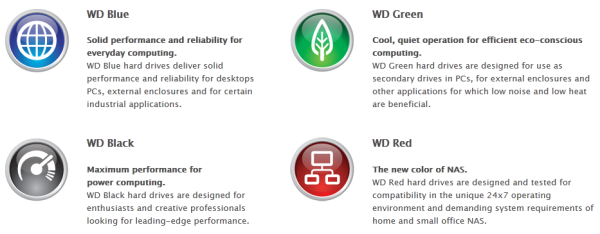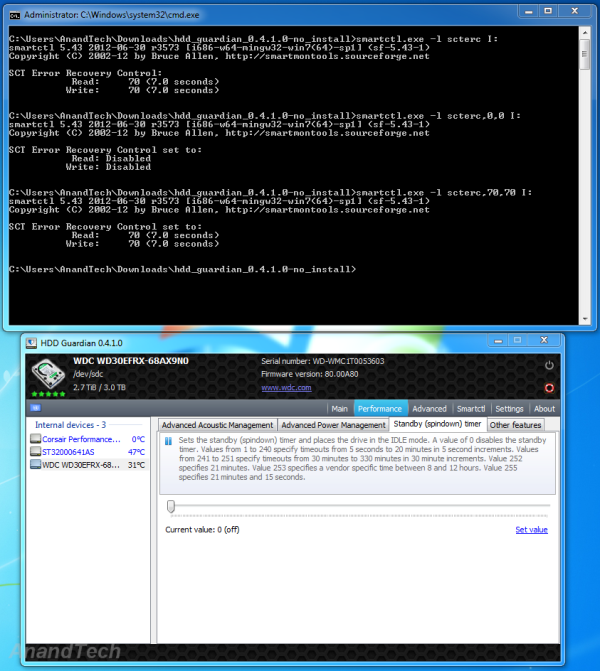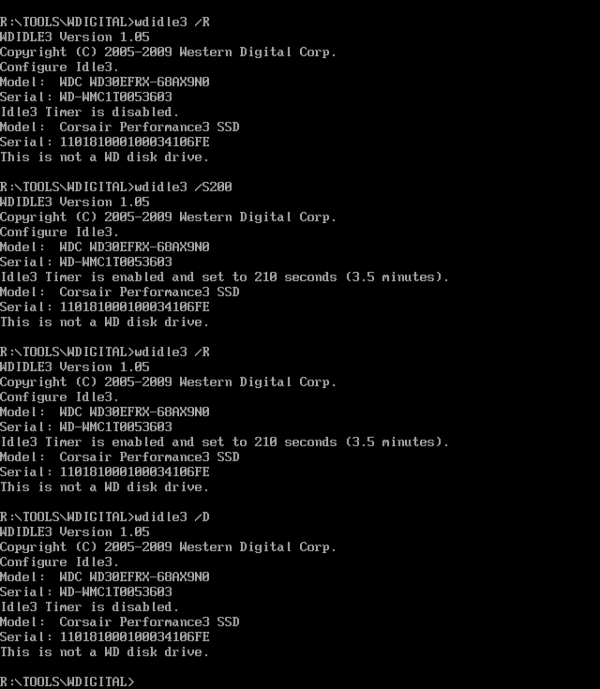Western Digital Red Review: Are NAS-optimized HDDs Worth the Premium?
by Ganesh T S on August 17, 2012 4:20 PM EST- Posted in
- Storage
- NAS
- Western Digital
WD Red Lineup: Differentiating Features
Western Digital has well-defined product categories for each market segment. The WD Black series caters to those requiring a lot of performance without power concerns. The Green series serves the opposite end of the spectrum, where performance is not that much of an issue (secondary drives for PCs / external enclosures), but heat and power could do with some reduction. The Blue series served the middle tier (everyday computing with optimal performance) and the notebook market. However, none of these models are recommended by WD for 24x7 operation (which happens to be an essential requirement for almost all NAS systems). Till now, none of the HDD vendors have anything specific for SMB / SOHO NAS systems. WD aims to capture this segment of the market with the WD Red lineup.
High end enterprise configurations are served by drives rated for stressful conditions (such as Seagate's Constellation and Cheetah lineups, WD's own RE4 and Hitachi's Ultrastar series). These drives commanded a huge price premium that even tempted some IT staff to fill their RAID arrays with consumer hard drives. Unfortunately, most of these temptations have resulted in bad results (particularly if the consumer hard drives have not been properly 'configured' prior to usage). What are the aspects which differentiate these enterprise drives from consumer versions?
SMART Command Transport Error Recovery Control: This feature allows the OS to set a soft time limit for completion of reads and writes. Seagate calls this ERC (Error Recovery Control). Samsung / Hitachi drives term this CCTL (Command Completion Time Limit), while Western Digital gives it the TLER (Time Limited Error Recovery) moniker. In a typical desktop drive, this could be a large number. In case of a bad sector or some other similar issue, the hard disk might keep retrying the access or try to remap the bad sector right away. The OS would remain waiting for the hard disk to deliver its delayed response. In a NAS environment, this delay could prove fatal, with the drive either being dropped or the NAS going into rebuild mode. So, it is essential that the SCT ERC number be set to a duration shorter than what the NAS OS would wait for before declaring the drive dead. Enterprise drives usually allow configuration of this value and set it by default to a low one (because the RAID controller can get hold of or recover the data from the other drives in the NAS).
Vibration Tolerance: NAS systems usually place a large number of drives close together. If vibrations aren't mitigated, it could result in decreased lifespan of the drives. Enterprise drives usually have increased vibration tolerance and also have in-built mechanisms to dampen themselves.
Higher MTBF and Longer Warranties: HDD vendors provide higher Mean Time Between Failures (MTBF) ratings for their enterprise drives and also walk the talk by usually providing longer warranties compared to the desktop drives.
If you are interested in further coverage of these aspects, this page serves as a good starting point. Some studies have shown that there is not much difference between desktop and enterprise hard drives with respect to real-life MTBFs. StorageMojo, in particular, has a number of posts stressing this viewpoint. Assuming that the end user has the data backed up, it is undeniable that the longer warranty period (in which RMA can be processed) is definitely an advantage. It is also likely that if the HDD vendor has enough faith to increase the warranty period, at least some improvements (particularly in the vibration tolerance mechanism) have been done compared to the consumer desktop versions.
Coming back to the WD Red, readers must be wondering how many of the above aspects can be brought to the consumers by WD without eating into their profit margins from the RE4 sales. We first start off with a overview of some of the aspects of the NASware firmware
Intelligent Error Recovery Control: This NASware feature corresponds to the TLER configuration. The value for the soft time limit can be set through smartctl, if the manufacturer allows it. We tried this out on the WD Red drive connected directly to our testbed.
We find that, by default, the soft limit is set to 7s. This means that all the NAS units certified to be compatible with the WD Red drives wait for more than 7s for a transaction to complete before dropping drives or starting a rebuild. The important aspect is that this value is configurable, and can even be completely disabled, as shown in the screenshot above.
Power Management Features: Some hard drives adopt aggressive head parking and disk spindown to save on power. For example, the WD Green drives were guilty of parking the head after just 8 seconds of inactivity. This increases the load cycle count unnecessarily (drives are usually rated for 300K cycles). Disk spindown (or standby) timer is an orthogonal parameter which actually stops the motor and puts the drive in IDLE mode. As the screenshot above shows, the standby timer is off by default, but this value can be altered through HDD Guardian or any other similar software. The head parking parameter is usually accessible through the Advanced Power Management (APM) feature of the hard drive. Unfortunately, HDD Guardian and other HDD tools indicated that there was no APM support in the WD Red. Eventually, we had to resort to running WD's own WDIDLE3 tool in the DOS mode. It turns out that the head parking interval is only accessible through a proprietary command and WD doesn't expose it to external tools.
As the screenshot above shows, head parking is completely disabled by default. It is also possible to set the head parking time limit, and it is sticky through power cycles. For NAS applications, it is better to leave it in the default state of head parking being disabled.
How does the WD Red achieve power optimization? The secret lies in IntelliPower. The WD Red drives spin at 5400 rpm as per the analysis done by the folks at SPCR. It is the combination of these features which allow the WD Reds to balance performance and also reduce power.
3D Active Balance : Vibration Reduction: WD claims that it is the first-to-market with 3D mechanical balancing technology for vibration reduction. This has obvious benefits in terms of decreasing noise and avoiding performance reduction. However, comparative measurements of this feature with the competition is outside the scope of this review.
Some of the other features of the WD Red drives include support for the ATA Streaming Command Set in the firmware. This allows optimal drive buffer management so as to ensure smooth streaming of AV data (particularly when the NAS is acting as a DLNA server). This obviously requires support in the NAS firmware also. In addition, we also have support for the SMART Command Set (SCT). We saw this earlier in this section when using smartctl to get / set the TLER parameters. Note that the SCT doesn't allow altering of the APM parameters for spindown / head parking, as they belong to the non-SMART device settings.













87 Comments
View All Comments
Peroxyde - Saturday, August 18, 2012 - link
Sorry for the silly questions, but can you please explain if there would be any harmful effects if the WD Red is used in the following scerarios? If not suitable, what would you advise to use instead? The goal is good reliability, storage capacity, performance is desirable but not the highest criteria.1. As standalone Hard drive (the only HD in the computer)
2. In external USB enclosure, USB 3.0
3. As second HD, just for storage
Thanks in advance for any advice
vgray35@hotmail.com - Saturday, August 18, 2012 - link
Good reliability and low power consumption is my first criteria, but the latter cannot be used to sacrifice the former. Both criteria lead to longer life cycles. The lower power GREEN and BLUE drives are designed with an eye towards rather low cycle life, and therefore low power as a criteria for these drives makes no sense whatsoever. It seems the only way to get reliability is to stay away from cheap low end consumer hard drives which is most of the drives out there.To me I do not differentiate between standalone, external storage, second hard drive, desktop or laptop, as these all demand good reliability and low power consumption for the best possible price. Performance is the next important criteria, but it is a fallacy to expect good performance from a 5400 rpm low power drive, and I no reason why the minimum spindle speed should not be 7200 rpm. Lower spindle speeds appear largely in the realm of low end consumer drives where reliability is very poor. Hard drive crashes plague the computer world because the majority of products are bad in the extreme, long lasting cheap consumer drives in some configurations notwithstanding. Just because someone says that they obtained a 3 year life span with cheap consumer drives, does not make them good drives generally, because that long life example is not typical for the majority of real world usage conditions. I now have a lower boundary criteria - "if it does not last in a laptop then it is not good for any purpose bar none".
So all this translates to never buy anything less than 7200 rpm to ensure a good shot at performance, and search for good drive designs with the lowest power consumption to have a good shot at longer life spans in any situation. Picking a low power drive simply to achieve low power drain, is more often than not the same thing as purposely selecting a LOW quality drive in terms of performance and cycle life, and such a definite requirement is very rare indeed. Why bother - extremes of low power means low performance, and often also very short cycle life.
There is very rarely a situation which does not demand extremes of temp cycling of the hard drives, which is what will lead to shorter life spans and hence poor reliability. I have come to the conclusion the classifications of standalone, external storage, 2nd drive, laptop, etc are not particularly useful if reliability and performance are important - and since when are these never important. These classifications have become justifications by the manufacturers for designing - "only as good as needed" devices. It is an excuse for designing crap product
Western Digital BLACK or RED is a minimal consumer drive quality level to be used in any application, and anything less reliable should never be graced with your dollars. Less reliable drives lasting for years in some particular situations is largely a myth - it happens only if certain criteria are meet, namely, low loads and small temp cycling, which rarely occurs in the real world of consumer computing. When looking at Western Digital drives, always stay away from GREEN and BLUE drives, simply because components are designed to last only under certain special conditions, and I believe these special operating conditions in practical terms are just a myth. In essence these manufacturers (marketing honchos) give credence to conditions of "LOW THERMAL CYCLING", which they then decree is a significant portion of the market place, when in reality it really does not exist, and only gives them an excuse to design "only as good as needed" devices. The existence of the low quality drives permits them to charge more than they normally could for the better drives. Don't believe the hype, the more expensive drives are required for good reliability and performance. apparently good news about GREEN and BLUE drives notwithstanding.
Don't ever buy too cheap, if you want to avoid repeated disk crashes, and there is nothing wrong with periodically replacing working drives with new ones periodically to avoid the inevitable disk crashes. Even good drives eventually fail. If the manufacturer specifies a 3y warranty, then replace the drives every 2 years.
You asked for advise on selecting drives, but what I am giving you really reads as a recipe for spending more money. You will not regret it.
What does "Drives certified for 24/7 really mean?" It means better able to handle temperature cycling arising from inadequate cooling or heavier loads, while still permitting reasonable cycle life. Reliability comes from 24/7 certification, with drives designed to handle extremes in both peak temperature and temp cycle, and drives not so certified belong to the mythical world of operating conditions where thermal cycling is less important. I have to realize all situations require 24/7 certification and to believe otherwise is a risky business.
So buy BLACK drives for all your applications as a minimum and occasionally you will need RED for better reliability. Personally I reckon RED only for me after prices have settled in the months ahead. I wonder if they make 2.5" RED drives.
Peroxyde - Saturday, August 18, 2012 - link
Thank you very much for the thorough explanation. With too much emphasis on NAS usage with the Red, I am still wondering if technically they can still function as a single drive outside of a NAS. Should people who don't have NAS device avoid buying the RED drives?Let's try a real example:
USB 3.0 External Drive: I hesitate between Caviar Black 1 TB, 5 years warranty, $100 et WD Red 2 TB, 3 years warranty $140. I am torn between the 5 years warranty of the black and the 2TB of the red. Reliability is the most important. This external drive will travel often and will be frequently powered on/off. What would you choose?
vgray35@hotmail.com - Saturday, August 18, 2012 - link
BLACK is cheaper but quality is a lot better than GREEN and BLUE, and BLACK may well be a good choice reliability wise.If RED is good for multi-drive RAID.operation, then it is definitely very good in terms of reliability in single drive applications. The 5 year warranty on BLACK seems a better deal right now. RED is new and needs time to unravel its true nature. BLACK has 300,000 load/unload cycles while RED is rated at 1,000,000, but the BLACK drive draws a lot less power. I would go with BLACK's 5y warranty instead of RED's 3y warranty
Make sure you have enough cooling and you know the drive's temperature during heavy loads.
Peroxyde - Saturday, August 18, 2012 - link
Cool thx. BTW, In the example above Black is not cheaper. It costs $100/TB while the Red is $140 for 2TB. I'll follow your advice, will buy the 1TB Black for now.vgray35@hotmail.com - Tuesday, August 21, 2012 - link
I have just read the SPCR review of RED drives, and these may well be a better choice all round over the BLACK drives, especially given the energy efficiency numbers, and the fact that 7200 rpm drives are not able to consistently outperform these 5400 rpm RED drives.Note that the 1T RED drive performance is quite a lot less than the 3TB drive, but is more energy efficient. The 3TB performance is good.
That RED 3y warranty is likely based on a NAS configuration (a harsher environment), which means a standalone drive is likely approaching a 5y warranty equivalent. I am beginning to change my mind on that BLACK drive purchase even with that 5y warranty.
http://www.silentpcreview.com/WD_Red
Watwatwat - Saturday, August 18, 2012 - link
Of course they function like any other drive outside of nas.worrying too much about reliability misses the point, you should buy two because one will fail with your data, its just a given, you need backup. don't buy yourself a false sense of security.
vgray35@hotmail.com - Monday, August 20, 2012 - link
I agree. Use that 2nd hard drive to replace the 1st drive BEFORE the warranty runs out, regardless of whether the 1st drive still seems OK.When you buy higher reliability drives this is not false security, just good business. False security is when one fails to also use backups.
Using backups, and hope that cheap GREEN and BLUE drives will be mitigated is a false hope. Recover from a failure is invariably always a very expensive proposition.
Isn't buying two the point about satisfying that worry? Backups are always a pain, cost money and time, and are painful when you have to resort to using them. Changing drives early invariably affords less pain.
SunLord - Saturday, August 18, 2012 - link
WD Red is un-gimped Raid friendly version of Green drive just like the RE drives are un-gimped raid friendly versions of Black drives. The only real differences between Red and Green is the firmwares they ship with having different settings the internals are all identical just like it is with Black and RE drives. I will admit the I've not taken apart a red drive but I have taken apart a Black and RE 1TB drives made with in 3 weeks of each other and they were 100% identical save for the stickers anyvgray35@hotmail.com - Monday, August 20, 2012 - link
And yet experience under load yields a different result, despite the fact that they look the same inside. There is something else afoot here besides firmware.